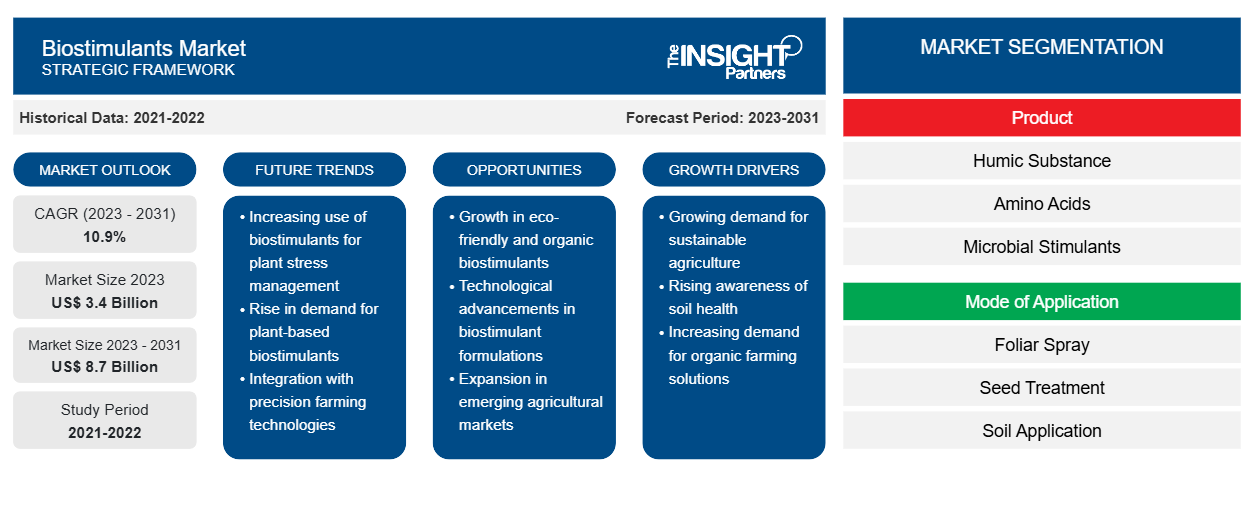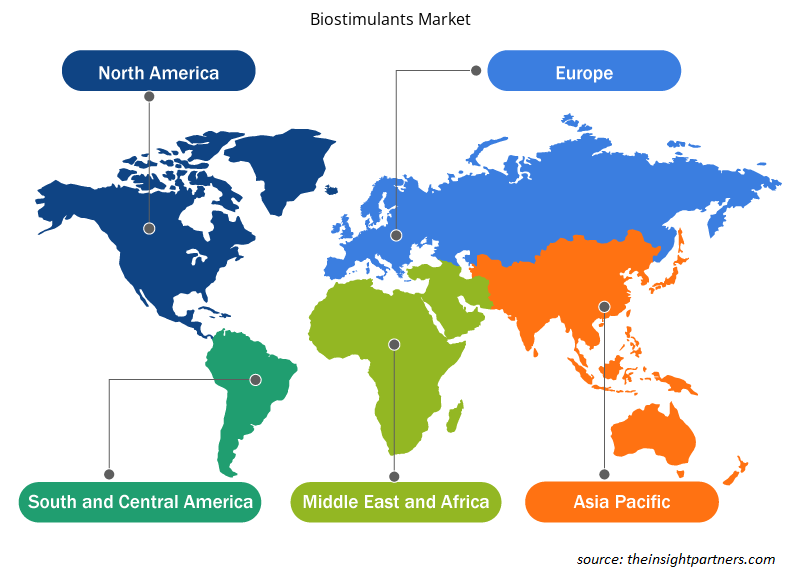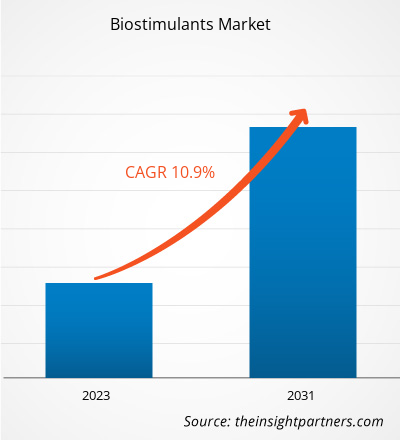Se proyecta que el tamaño del mercado de bioestimulantes alcance los 8.410 millones de dólares estadounidenses para 2031, frente a los 5.550 millones de dólares estadounidenses de 2024. Se espera que el mercado registre una tasa de crecimiento anual compuesta (TCAC) del 6,3 % entre 2025 y 2031. Se prevé que los crecientes avances tecnológicos en el desarrollo de bioestimulantes generen nuevas tendencias en el mercado durante el período de pronóstico.
Análisis del mercado de bioestimulantes
Los bioestimulantes han ganado popularidad debido a la transición hacia la agricultura orgánica y a su integración con fertilizantes químicos. Son populares como estimuladores del crecimiento vegetal y ayudan a fortalecer la biomasa radicular, la absorción de nutrientes y la actividad enzimática. Esto ha impulsado a las empresas clave a aumentar considerablemente su capacidad de producción. Los bioestimulantes ricos en minerales, fitohormonas y aminoácidos incentivan a los agricultores a optar por estos productos. Los bioestimulantes son productos que mejoran los procesos nutricionales de las plantas independientemente de su contenido nutricional. Estos bioestimulantes pueden utilizarse como sustancias húmicas, aminoácidos, estimulantes microbianos, extractos de algas marinas , entre otros. Se utilizan para cereales y granos, oleaginosas y legumbres, frutas y verduras, césped y paisajismo, entre otros.
Descripción general del mercado de bioestimulantes
Los bioestimulantes son una mezcla de sustancias o microorganismos que ayudan a mejorar las condiciones de los cultivos sin afectar negativamente al medio ambiente. Diversos estudios han demostrado que los bioestimulantes pueden utilizarse como aditivos para fertilizantes, lo que ayuda a reducir su uso. También pueden favorecer la absorción de nutrientes, el crecimiento de las plantas y la tolerancia al estrés abiótico. Favorecen los procesos metabólicos de las plantas que facilitan la absorción de nutrientes esenciales. Existen diversos métodos de aplicación de bioestimulantes. Pueden utilizarse en polvo, gránulos o como producto foliar líquido para la preparación del suelo. El mercado global de bioestimulantes está segmentado según el producto, el modo de aplicación y el tipo de cultivo.
Personalice este informe según sus necesidades
Recibirá personalización de cualquier informe, sin cargo, incluidas partes de este informe o análisis a nivel de país, paquete de datos de Excel, así como también grandes ofertas y descuentos para empresas emergentes y universidades.
Mercado de bioestimulantes: perspectivas estratégicas

-
Obtenga las principales tendencias clave del mercado de este informe.Esta muestra GRATUITA incluirá análisis de datos, desde tendencias del mercado hasta estimaciones y pronósticos.
Impulsores y oportunidades del mercado de bioestimulantes
Políticas e iniciativas gubernamentales favorables
La Unión Europea ha apoyado la adopción de bioestimulantes mediante marcos regulatorios que garantizan su uso seguro y eficaz en la agricultura. La Unión Europea ha establecido marcos regulatorios claros para regular el uso de bioestimulantes. El Reglamento (UE) n.º 1107/2009 (que abarca los productos fitosanitarios) y el más reciente Reglamento (UE) n.º 2019/1009 sobre bioestimulantes proporcionan directrices claras para los productos bioestimulantes, garantizando su seguridad y eficacia. Esta claridad regulatoria ha fomentado una adopción más generalizada de bioestimulantes por parte de los agricultores de toda Europa. Además, el Pacto Verde Europeo, con su Estrategia «De la Granja a la Mesa», prioriza la mejora de la eficiencia de los recursos, una economía limpia y circular, la restauración de la biodiversidad y la reducción de la contaminación. Este avance hacia los objetivos de sostenibilidad impulsa la demanda de productos agrícolas respetuosos con el medio ambiente, incluidos los bioestimulantes, para lograr el objetivo de posicionar a Europa como la primera región climáticamente neutra para 2050.
Además, los subsidios, las subvenciones y los incentivos fiscales incentivan a los agricultores a adoptar alternativas ecológicas, y programas nacionales, como el Paramparagat Krishi Vikas Yojana (PKVY) de la India y la Iniciativa de Transición Orgánica del USDA, apoyan la agricultura orgánica, impulsando indirectamente la demanda de bioestimulantes. Los gobiernos también financian la I+D en soluciones agrícolas de base biológica, lo que impulsa aún más el crecimiento del sector y la concienciación de los agricultores. Estas políticas se alinean con los objetivos globales de sostenibilidad, consolidando los bioestimulantes como una herramienta clave en la agricultura climáticamente inteligente.
Integración de Bioestimulantes con Fertilizantes Químicos
El uso excesivo de fertilizantes químicos ha afectado las masas de agua. Los nutrientes se extraen de las explotaciones agrícolas y llegan a ríos, lagos y estanques cercanos, causando eutrofización. Además, la eficiencia de uso de los fertilizantes químicos es baja. Esto significa que las plantas solo absorben una mezcla de nutrientes. Por ejemplo, nutrientes esenciales, como el fósforo, precipitan tras ser añadidos al suelo y, por lo tanto, permanecen menos disponibles para las plantas. Asimismo, el nitrógeno, otro nutriente esencial, puede quedar indisponible debido a factores como la lixiviación de nitratos.
La gestión sostenible de los recursos se puede lograr mediante la integración de bioestimulantes con fertilizantes químicos, ya que ayuda a optimizar la absorción de nutrientes, estimula el desarrollo robusto de los cultivos y potencialmente reduce la dependencia de fertilizantes sintéticos. Esta estrategia también puede reducir la contaminación ambiental causada por el uso excesivo de fertilizantes. Si bien los productos bioestimulantes pueden suponer una mayor inversión inicial en comparación con ciertos fertilizantes químicos convencionales, sus ventajas agronómicas y económicas, como mayores rendimientos y mayores ganancias para los agricultores, pueden generar una mayor rentabilidad de la inversión a largo plazo. Por ejemplo, un estudio publicado por la Revista Italiana de Agronomía sobre el trigo duro reveló que la aplicación de bioestimulantes puede mejorar considerablemente los parámetros morfofisiológicos clave y el rendimiento del grano, a la vez que ofrece el potencial de reducir la dependencia de los fertilizantes nitrogenados sintéticos. Por lo tanto, es probable que las ventajas mencionadas fomenten la dependencia de los bioestimulantes y, posteriormente, impulsen la expansión del mercado de bioestimulantes en los próximos años.
Análisis de segmentación del informe de mercado de bioestimulantes
Los segmentos clave que contribuyeron a la derivación del análisis del mercado de bioestimulantes son el tipo de producto, el modo de aplicación y el tipo de cultivo.
- Según el tipo de producto, el mercado de bioestimulantes se segmenta en sustancias húmicas, aminoácidos, estimulantes microbianos, extractos de algas, entre otros. El segmento de extractos de algas representó la mayor participación en el mercado mundial de bioestimulantes en 2024.
- Por modo de aplicación, el mercado de bioestimulantes se segmenta en pulverización foliar, tratamiento de semillas y aplicación al suelo. El segmento de pulverización foliar tuvo la mayor participación en el mercado de bioestimulantes en 2024.
- En cuanto al tipo de cultivo, el mercado de bioestimulantes se segmenta en cereales y granos, oleaginosas y legumbres, frutas y hortalizas, césped y paisajismo, entre otros. El segmento de cereales y granos tuvo la mayor participación en el mercado de bioestimulantes en 2024.
Análisis de la cuota de mercado de bioestimulantes por geografía
El alcance geográfico del informe de mercado de bioestimulantes se divide en cinco regiones: América del Norte, Asia Pacífico, Europa, Oriente Medio y África, y América del Sur y Central. Se prevé un crecimiento significativo del mercado de bioestimulantes en Asia Pacífico durante el período de pronóstico.
El mercado de bioestimulantes en Asia Pacífico es importante debido a la creciente concienciación de los agricultores y a la creciente demanda de alimentos derivada del crecimiento demográfico. Se prevé que el aumento de la demanda de productos agrícolas y la creciente necesidad de productos orgánicos impulsen el consumo de bioestimulantes en la región de Asia Pacífico, especialmente en China, Japón e India. Dado su competitivo y creciente sector agrícola, estos países asiáticos determinan un alto índice de consumo de productos. Fabricantes de diversos países de Asia Pacífico están desarrollando productos únicos con una eficiencia superior y bajos niveles de toxicidad. Por ejemplo, en 2021, Sea6 Energy, Bengaluru, una startup con sede en India, obtuvo la primera patente del país para un producto bioestimulante. La empresa también cuenta con numerosos productos exclusivos derivados de algas rojas.
A medida que los consumidores son más conscientes de los beneficios de una dieta saludable, la popularidad de los alimentos orgánicos ha aumentado. Esta concienciación ha impulsado el uso creciente de fertilizantes orgánicos, que sustituyen los métodos agrícolas convencionales, que dependen en gran medida de fertilizantes químicos. Los bioestimulantes desempeñan un papel esencial en la mejora de la eficiencia nutricional y la tolerancia al estrés abiótico. Por lo tanto, se espera que la demanda de bioestimulantes en la agricultura orgánica impulse el mercado en la región.
Perspectivas regionales del mercado de bioestimulantes
Los analistas de Insight Partners han explicado detalladamente las tendencias y los factores regionales que influyen en el mercado de bioestimulantes durante el período de pronóstico. Esta sección también analiza los segmentos y la geografía del mercado de bioestimulantes en América del Norte, Europa, Asia Pacífico, Oriente Medio y África, y América del Sur y Central.

- Obtenga los datos regionales específicos para el mercado de bioestimulantes
Alcance del informe de mercado de bioestimulantes
| Atributo del informe | Detalles |
|---|---|
| Tamaño del mercado en 2024 | 5.500 millones de dólares estadounidenses |
| Tamaño del mercado en 2031 | US$ 8.41 mil millones |
| CAGR global (2025-2031) | 6,3% |
| Datos históricos | 2021-2023 |
| Período de pronóstico | 2025-2031 |
| Segmentos cubiertos |
Por tipo de producto
|
| Regiones y países cubiertos |
América del norte
|
| Líderes del mercado y perfiles de empresas clave |
|
Densidad de actores del mercado de bioestimulantes: comprensión de su impacto en la dinámica empresarial
El mercado de bioestimulantes está en rápido crecimiento, impulsado por la creciente demanda del usuario final debido a factores como la evolución de las preferencias de los consumidores, los avances tecnológicos y un mayor conocimiento de los beneficios del producto. A medida que aumenta la demanda, las empresas amplían su oferta, innovan para satisfacer las necesidades de los consumidores y aprovechan las tendencias emergentes, lo que impulsa aún más el crecimiento del mercado.
La densidad de actores del mercado se refiere a la distribución de empresas o compañías que operan en un mercado o sector en particular. Indica cuántos competidores (actores del mercado) hay en un mercado determinado en relación con su tamaño o valor total.
Las principales empresas que operan en el mercado de bioestimulantes son:
- BASF SE
- UPL Limitada
- Valagro
- Compañía Gowan
- Corporación FMC
- ILSA SpA
Descargo de responsabilidad : Las empresas enumeradas anteriormente no están clasificadas en ningún orden particular.

- Obtenga una descripción general de los principales actores clave del mercado de bioestimulantes
Noticias y desarrollos recientes del mercado de bioestimulantes
El mercado de bioestimulantes se evalúa mediante la recopilación de datos cualitativos y cuantitativos tras la investigación primaria y secundaria, que incluye importantes publicaciones corporativas, datos de asociaciones y bases de datos. Algunos de los desarrollos clave en el mercado de bioestimulantes son los siguientes:
- UPL AgroSolutions Canada ha lanzado su bioestimulante Wave en Canadá, tras su registro ante la Agencia Canadiense de Inspección de Alimentos. (Fuente: UPL Ltd, comunicado de prensa, enero de 2023)
- La tecnología bioestimulante de IntraCrop, presentada en la edición checa de National Geographic, demostró que aumenta el rendimiento de los cultivos hasta en un 15 % con un uso reducido de fertilizantes. (Fuente: Comunicado de prensa de IntraCrop, noviembre de 2024)
Informe de mercado sobre bioestimulantes: cobertura y resultados
El informe "Tamaño y pronóstico del mercado de bioestimulantes (2021-2031)" ofrece un análisis detallado del mercado que abarca las siguientes áreas:
- Tamaño del mercado de bioestimulantes y pronóstico a nivel global, regional y nacional para todos los segmentos clave del mercado cubiertos bajo el alcance
- Tendencias del mercado de bioestimulantes, así como dinámicas del mercado como impulsores, restricciones y oportunidades clave
- Análisis detallado de las cinco fuerzas de Porter y FODA
- Análisis del mercado de bioestimulantes que abarca las tendencias clave del mercado, el marco global y regional, los principales actores, las regulaciones y los desarrollos recientes del mercado.
- Análisis del panorama industrial y de la competencia que abarca la concentración del mercado, el análisis de mapas de calor, los actores destacados y los desarrollos recientes del mercado de bioestimulantes.
- Perfiles detallados de empresas
- Análisis histórico (2 años), año base, pronóstico (7 años) con CAGR
- Análisis PEST y FODA
- Tamaño del mercado, valor/volumen: global, regional y nacional
- Industria y panorama competitivo
- Conjunto de datos de Excel
Informes recientes
Informes relacionados
Testimonios
Razón para comprar
- Toma de decisiones informada
- Comprensión de la dinámica del mercado
- Análisis competitivo
- Información sobre clientes
- Pronósticos del mercado
- Mitigación de riesgos
- Planificación estratégica
- Justificación de la inversión
- Identificación de mercados emergentes
- Mejora de las estrategias de marketing
- Impulso de la eficiencia operativa
- Alineación con las tendencias regulatorias






















 Obtenga una muestra gratuita para - Mercado de bioestimulantes
Obtenga una muestra gratuita para - Mercado de bioestimulantes